Ficus sycomorus
Ficus sycomorus, called the sycamore fig or the fig-mulberry (because the leaves resemble those of the mulberry), sycamore, or sycomore, is a fig species that has been cultivated since ancient times.
| Ficus sycomorus | |
|---|---|
 | |
| Leaves and syconia of Ficus sycomorus | |
| Scientific classification | |
| Kingdom: | Plantae |
| Clade: | Tracheophytes |
| Clade: | Angiosperms |
| Clade: | Eudicots |
| Clade: | Rosids |
| Order: | Rosales |
| Family: | Moraceae |
| Genus: | Ficus |
| Subgenus: | F. subg. Sycomorus |
| Species: | F. sycomorus |
| Binomial name | |
| Ficus sycomorus | |
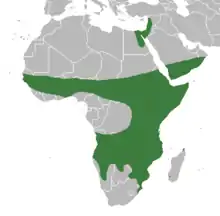 | |
The term sycamore spelled with an A has also been used for unrelated trees: the great maple, Acer pseudoplatanus, or plane trees, Platanus. The spelling "sycomore", with an O rather than an A as the second vowel is, if used, specific to Ficus sycomorus.[2][3]
Distribution
Ficus sycomorus is native to Africa south of the Sahel and north of the Tropic of Capricorn, also excluding the central-west rainforest areas. It also grows naturally in Lebanon; in the southern Arabian Peninsula; in Cyprus; in very localised areas in Madagascar; and in Israel, Palestine and Egypt. In its native habitat, the tree is usually found in rich soils along rivers and in mixed woodlands.
Description
Ficus sycomorus grows to 20 m tall and has a considerable spread, with a dense round crown of spreading branches. The leaves are heart-shaped with a round apex, 14 cm long by 10 cm wide, and arranged spirally around the twig. They are dark green above and lighter with prominent yellow veins below, and both surfaces are rough to the touch. The petiole is 0.5–3 cm long and pubescent. The fruit is a large edible fig, 2–3 cm in diameter, ripening from buff-green to yellow or red. They are borne in thick clusters on long branchlets or the leaf axil. Flowering and fruiting occurs year-round, peaking from July to December. The bark is green-yellow to orange and exfoliates in papery strips to reveal the yellow inner bark. Like all other figs, it contains a latex.
Cultivation
According to botanists Daniel Zohary and Maria Hopf, cultivation of this species was "almost exclusively" by the ancient Egyptians.[4]: 130 Remains of F. sycomorus begin to appear in predynastic times and occur in quantity from the start of the third millennium BC. It was the ancient Egyptian Tree of Life.[5] Zohary and Hopf note that "the fruit and the timber, and sometimes even the twigs, are richly represented in the tombs of the Egyptian Early, Middle and Late Kingdoms."[4]: 131 In numerous cases the parched fruiting bodies, known as sycons, "bear characteristic gashing marks indicating that this art, which induces ripening, was practised in Egypt in ancient times."[4]: 131
Although this species of fig requires the presence of the symbiotic wasp Ceratosolen arabicus to reproduce sexually, and this insect is extinct in Egypt, Zohay and Hopf have no doubt that Egypt was "the principal area of sycamore fig development."[4]: 131 Some of the caskets of mummies in Egypt are made from the wood of this tree. In tropical areas where the wasp is common, complex mini-ecosystems involving the wasp, nematodes,[6][7] other parasitic wasps, and various larger predators revolve around the life cycle of the fig. The trees' random production of fruit in such environments assures its constant attendance by the insects and animals which form this ecosystem.
A study in 2015 indicated that the sycamore tree was brought to Israel by Philistines during the Iron Age, along with opium poppy and cumin.[8][9] These sycamore trees used to be numerous in western Beirut, lending their name to the neighborhood of Gemmayzeh ((الْجُمَّيْزَة al-Ǧummayzah), "sycamore fig").[10] However, the trees have largely disappeared from this area.[11]
Gardens
In the Near East F. sycomorus is an orchard and ornamental tree of great importance and extensive use. It has wide-spreading branches and affords shade.
In religion
Judaism and Christianity
In the Bible, the sycomore is referred to seven times in the Old Testament (Hebrew שִׁקְמָה shiḳmah; Strong's number 8256) and once in the New Testament (συκομoραία sykomoraia or συκομορέα sykomorea;[12] Strong's number 4809). The sycomore was a popular and valuable fruit tree in Jericho and Canaan.[13]
- Hebrew Bible
- In the Psalms, sycomores are listed with vines as sources of food destroyed in the plagues inflicted on the Egyptians. Ps 78:47 This verse implies that Ficus sycomorus could not survive in the mountainous regions of Egypt[13] ("He destroyed their vines with hail, and their sycomore trees with frost." Ps 78:47).
- King David appointed an officer to look after the olives and sycomores of the western foothills. 1Chron 27:28
- King Solomon made cedars (a more valuable tree) as common as sycomores. 1Kings 10:27 = 2Chron 1:15, 2Chron 9:27
- In condemning his people's arrogance the prophet Isaiah also makes a contrast between sycomores and cedars. Isaiah 9:10
- The prophet Amos refers to his secondary occupation as a dresser or tender of sycomores Amos 7:14; this involved slashing the fruits to induce ripening.[4]: 131
- Gospels
- In the Gospel of Luke, Zacchaeus resorted to climbing a sycomore in order to get a better view of Jesus in Jericho. Luke 19:4
- Mishnah and Gemara (Talmud)
- In the Mishnah, in chapter 9 of tractate Shevi'it of order Zera'im, the borders of the various districts of the Land of Israel are delineated. The Upper Galilee is defined as the area north of Kfar Hananya where the sycomore does not grow; the Lower Galilee is the area south of Kfar Hananya where the sycomore does grow.
- Tractate Berakhot of the Gemara mentions sycomore in reference to tithing, and to its subsequent appropriate blessing.
- Tractate Pesachim- 53a:8 of the Gemara mentions sycomore in reference to identifying geographic regions, in this case a plain, to determine dates for various purposes.
Other religions
In Kikuyu religion, the sycomore is a sacred tree. All sacrifices to Ngai (or Murungu), the supreme creator, were performed under the tree. Whenever the mugumo tree fell, it symbolised a bad omen and rituals had to be performed by elders in the society. Some of those ceremonies carried out under the Mugumo tree are still observed.[14][15]
Gallery
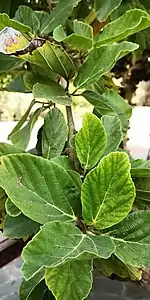 Leaves
Leaves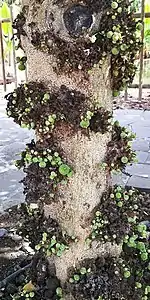 Trunk with unripe fruit
Trunk with unripe fruit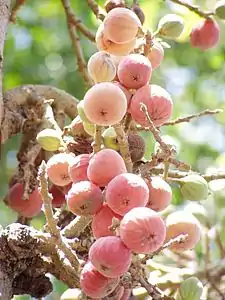 Fruit and syconia
Fruit and syconia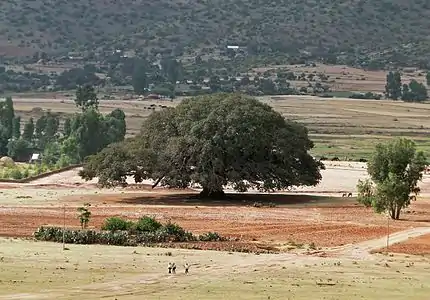 In Ethiopia
In Ethiopia
See also
References
- Botanic Gardens Conservation International (BGCI).; IUCN SSC Global Tree Specialist Group (2019). "Ficus sycomorus". IUCN Red List of Threatened Species. 2019: e.T146188430A146199148. doi:10.2305/IUCN.UK.2019-2.RLTS.T146188430A146199148.en. Retrieved 19 November 2021.
- "sycomore". Merriam-Webster.com. Retrieved 30 October 2016.
- "sycamore". Collins English Dictionary. Retrieved 30 October 2016.
- Zohary, Daniel; Hopf, Maria (2012). Domestication of plants in the Old World (fourth ed.). Oxford University Press.
- Assmann, Jan; Lorton, David (2005). Death and salvation in ancient Egypt. translated by David Lorton. Cornell University Press. p. 171. ISBN 978-0-8014-4241-4.
- Susoy, Vladislav; Herrmann, Matthias; Kanzaki, Natsumi; Kruger, Meike; Nguyen, Chau N.; Rödelsperger, Christian; Röseler, Waltraud; Weiler, Christian; Giblin-Davis, Robin M.; Ragsdale, Erik J.; Sommer, Ralf J. (2016). "Large-scale diversification without genetic isolation in nematode symbionts of figs". Science Advances. 2 (1): e1501031. Bibcode:2016SciA....2E1031S. doi:10.1126/sciadv.1501031. PMC 4730855. PMID 26824073.
- Kruger, Meike S.; Kanzaki, Natsumi; Giblin-Davis, Robin M.; Greeff, Jaco M. (10 August 2021). "Molecular diversity and relationships of fig associated nematodes from South Africa". PLOS ONE. 16 (8): e0255451. Bibcode:2021PLoSO..1655451K. doi:10.1371/journal.pone.0255451. ISSN 1932-6203. PMC 8354458. PMID 34375357.
- "Philistines introduced sycamore, cumin and opium poppy into Israel during the Iron Age", Science daily, 28 August 2015, retrieved 25 October 2015.
- Frumin, Suembikya; Maeir, Aren M.; Kolska Horwitz, Liora; Weiss, Ehud (25 August 2015), "Nature", Scientific Reports, 5 (1): 13308, doi:10.1038/srep13308, PMC 4642518, PMID 26304818.
- Gemmmayzeh name origins., 25 July 2019
- Quilty, Jim; Diab, Leila (31 August 2005). "Gemmayzeh changing: new habits come to an old quarter". The Daily Star. Retrieved 16 November 2021.
... named after a sycamore tree that was once a landmark here.
- συκομορέα. Liddell, Henry George; Scott, Robert; A Greek–English Lexicon at the Perseus Project.
- Moldenke, Harold N. (1952). Plants of the Bible. Waltham, Massachusetts USA: Chronica Botanica Company. pp. 106–108.
- "Gikuyu Origins". Mukuyu. 13 November 2008. Retrieved 9 April 2015.
- Mbiti, John (1990). African Religions and Philosophy. Oxford University Press.
External links
- Figweb.org - Ficus sycomorus
- PBS Nature documentary: The Queen of Trees (on the sycamore fig in Kenya)
- Ficus sycomorus in West African plants – A Photo Guide.
